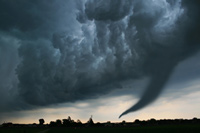
Tornados can form with little to no warning and leave in their wake a path of destruction. It is important that every individual is prepared for such an event. When a tornado is imminent, you have only a short amount of time to act. Advance planning and quick response are the keys to surviving a tornado.
Before a Tornado:
- Have at least a 5 day Disaster Supplies Kit assembled.
- Obtain a NOAA Weather Radio to monitor severe weather.
- If you do not have a weather radio, stay tuned to local radio or television.
- Learn the early warning systems available in Palm Beach County.
- Conduct tornado drills at least annually and practice your response to a tornado threat.
- Learn what the terms tornado watch and tornado warning mean so that you clearly understand the risk to your family and your community.
- A “Tornado Watch” is issued by the National Weather Service when tornadoes are possible or conditions are favorable in your area. Remain alert for approaching storms. This is the time to remind family members where the safest places within your home are located, and listen to the radio or television for further developments.
- A “Tornado Warning” is issued when a tornado has been sighted or indicated by weather radar. Take shelter immediately!
Tornado Danger Signs:
- Tornadoes can form from any thunderstorm and touch down with little or no advance warning.
- An approaching cloud of debris can mark the location of a tornado, even if a funnel is not visible.
- Before a tornado hits, the wind may die down, and the air may become very still.
- Tornadoes generally occur near the trailing edge of a thunderstorm, so it is often possible to see clear, sunlit skies behind the funnel.
During a Tornado:
- Go at once to a windowless interior room (bathroom or closet) or inner hallway without windows on the lowest level of the building.
- Get away from the windows.
- Go to the center of the room. Stay away from corners because they tend to attract debris.
- Get under a piece of sturdy furniture such as a workbench or heavy table or desk and hold on to it; otherwise use your arms to protect your head and neck.
- Gather emergency supplies and listen to a local radio or television station for further information.
At Work or School:
- Go to a windowless, interior room (bathroom, closet, or hallway) at the lowest level of the building.
- Put as many walls as possible between you and the outside.
- Stay out of structures with wide free-span roofs like auditoriums, gyms, cafeterias, and shopping centers.
- Stay away from windows and glass doors.
- Keep a battery-powered radio tuned to a local station, and follow emergency instructions.
- Use the telephone only for emergency calls.
In Mobile Homes:
Mobile homes are particularly vulnerable. Do not remain in a mobile home if a tornado is approaching. Predetermine safe shelter locations. When a tornado watch is issued, take shelter in a building with a strong foundation. If shelter is not available, lie in a ditch or low-lying area a safe distance away from the mobile home.
In a Car or Outside:
Do not try to outrun a tornado in your car; instead, leave the vehicle immediately for safe shelter. Do not seek shelter under an overpass or bridge. If caught outside or in a vehicle, get inside a nearby building if possible. If not, lie flat in a nearby ditch or depression and cover your head with your arms. Be aware of flying debris and rising water.